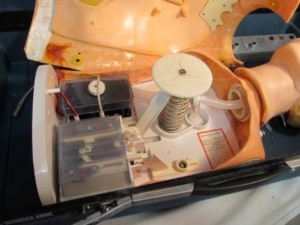ANNIE…ANNIE… ARE YOU OK? RESUSCI ANNE
Annie…Annie… Are You OK? The evolution of Resusci Anne


In the early 1970s, cardiopulmonary resuscitation (CPR) training reached the emergency response communities through the training doll, Resusci-Annie. Almost every training session began with the words “Annie…Annie…Are you okay?” as new EMTs, nurses, firefighters, and police officers learned the first step in CPR – establish unresponsiveness. Today the call has been shortened to “Are you okay?”, but Annie’s legacy continues, as she and her family have made the past 50 years of CPR training possible.
The first Resusci-Annie was developed by Asmund Laerdal, a successful toy maker, and Bjorn Lind, an anaesthesiologist. In the 1950s, Laerdal was manufacturing imitation wounds for Red Cross first aid training in Norway and Sweden, when he learned of the new CPR resuscitation technique, and envisioned life-sized mannequins as the ideal training tool and he set to work.
Resusci-Annie debuted in September 1960 in Stavanger, Norway at the First International Symposium on Resuscitation. The symposium was attended by US EMS pioneers Drs. Peter Safar, James Elam, Archer Gordon, Henning Ruben, and Rudolf Frey. Dr. Safar and Dr. Elam began working with Laerdal and his team refining Annie.


BUT WHO WAS ANNE? THE GIRL FROM THE RIVER SEINE
In the late 1880s, the body of a young girl was pulled from the River Seine at Quai du Louvre in Paris, France. There was no evidence of violence and it was assumed she had taken her own life. Since she could not be identified, a death mask was made; which was customary in such cases.

The young girl’s delicate beauty and smile added to the enigma of her death, which inspired stories and poetry of her demise, thought to be from suicide to escape an unrequited love. The story of L’Inconnue de la Seine (“The Unknown of the Seine”) became popular throughout Europe, as did reproductions of her death mask.


Asmund Laerdal knew the story of the death mask of L’Inconnue de la Seine, thought her features were beautiful and perfect for the purpose of a resuscitation mannequin. Laerdal chose to make its face female, recognizing that men might be reluctant to kiss a male image. He kept the name of the popular toy doll he was successfully manufacturing, and named the mannequin Rescusci-Annie.
ORIGINAL 1970S RESUSCI ANNE


The first Resusci-Annies were crude and simple compared to the electronic descendants made today, but they were effective, giving thousands the opportunity to practice the hands on skills that for many would be very rarely used. Instructors showed how to properly extend the neck in order to open the airway and ventilate; the neck had embedded rubber bladders by which the instructor could produce a carotid pulse with a hand held bulb.





The body consisted of a spring metal hoop which simulated the ribs, and provided the foundation for the chest upon which compressions could be done. Attached was a plastic “lung”, and a simulated anterior thorax/breastplate. The remainder of the body was essentially a plastic balloon which the instructor inflated for each class with a provided foot pump. Successful performance of ventilation and compression were measured by pressure developed within the lungs on aneroid gauges visible to the student. Between classes the body was thoroughly cleaned, deflated, folded, and returned to her storage box.
RECORDING RESUSCI-ANNIE
The next generation of Resusci-Annie were made with foam rather than a blowup body. Measurement of successful ventilation and compression was provided by pressure sensors which lit a display on a mounted pod. The pod also contained an electronic metronome to teach the appropriate compression rates. Perfection in performance became the requirement for earning certification. Students were expected to produce an EKG like paper strip demonstrating proper timing, depth, and sequence of events. Carotid pulse could still be simulated, and the pupils of the new training dolls could dilate and constrict with an inflatable bulb. Newer versions would now have individual mouth/lips for each student to apply and replaceable lungs that no longer required cleansing.



New models also included an infant Resusci-Baby, followed by a child mannequin, and an African-American version. As ALS training progressed, Laerdal developed an Annie with electrodes capable of mating with their arrhythmia simulator and accepting a reduced but actual defibrillation.



During the 1990s focus was shifted to more sufficient hands-on practice. Little Annie was introduced in 1995 as a supplemental trainer to meet this need and the need for a lower cost/lower student-mannequin ratio.

In the 2000s research demonstrated that even health care providers deliver poor quality CPR and the growing concern about patient safety and cost efficiency caused increased focus on patient simulation and self-directed learning, which provided measurement and feedback to improve CPR performance. These improvements led to the current generation of computer-mated displays and full simulation; SimMan 3G is the culmination of this experience.
IN THE END, RESUSCI ANNE HAS BEEN RESPONSIBLE FOR TRAINING MILLIONS IN THE SKILL OF CPR, BUT IT WAS INEVITABLE THAT MEMBERS OF OUR PROFESSION
HAVE SPAWNED NUMEROUS PRANKS TO LIGHTEN THE MOOD OF SUCH A SERIOUS UNDERTAKING:
So you thought you wanted to learn CPR
Submitted to NEMSM August 2011 by Mark Peck, EMT-P
